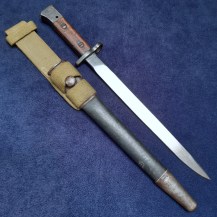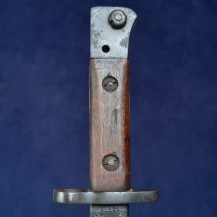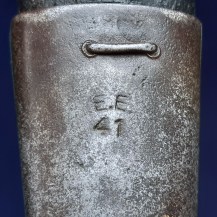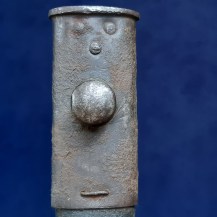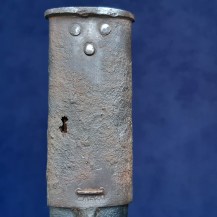Indian 1907 Pattern Mk III Bayonet, by Ishapore
Plain unfullered knife blade with clipped point and 2-inch false edge. Wood grips secured by two screws, squared pommel with oil hole. Black leather scabbard with iron throat and chape, khaki canvas frog.
The bayonet is stamped on one side at the ricasso with the Tudor Crown, also known as the Imperial Crown for its use throughout the British Empire, ‘G.R.I’ (Georgius Rex Imperator, meaning George VI, who was the last Emperor of India until its independence in 1947), ‘MkII’, the bayonet model, ’9 43’, meaning the bayonet was manufactured in September 1943, and ‘R.F.I’, meaning the manufacturer, the Rifle Factory Ishapore. It is stamped on the other side with three Indian inspection marks. The scabbard leather is stamped next to the seam with ‘W’ indicating that the leather was impregnated with wax as part of the manufacture process, and ‘ca1942’ indicating that it was manufactured by the Government Harness and Saddlery Factory at Cawnpore in 1942. The throat piece of the scabbard is stamped next to the staple with ‘C^320’, with ^ being a broad arrow War Department mark. The chape piece of the scabbard is stamped next to the staple with ‘E.E. 41’, indicating it was manufactured in 1941 by a different contractor.
You may notice that the model stamp is incorrect – this is certainly a MkIII due to its squared pommel, but the stamp shows ‘MkII’. Incorrect factory stamping is a known phenomenon with Indian bayonets, as well as failing to add stamps for conversions, factory repairs and so on. See British & Commonwealth Bayonets by Skennerton & Richardson, p348 and 351: they write that it is particularly common to see MkIIIs stamped as MkIIs.
These bayonets were made to fit the many SMLE No. 1 rifles made at Ishapore. Over time Indian bayonets became progressively simplified from the original 1907 Pattern design: the MkIII differed from the MkII in having a squared pommel and straight grips (without the curve to the belly of the grip found on other 1907 Patterns).
The blade is clean and bright with an even finish and no edge damage. It has been blued at the ricasso and on the hilt, tang and pommel – the pommel shows some wear to its blueing with some patches of light pitting. A few dents to the wood grips. The locking button is fully functional. The scabbard leather is good with only a few very small dents to its surface. The chape piece of the scabbard has some patination. The throat piece of the scabbard has extensive pitting leaving a rough surface, and has rusted through at one spot on its reverse side creating a small hole. This is hidden with the frog in place.


